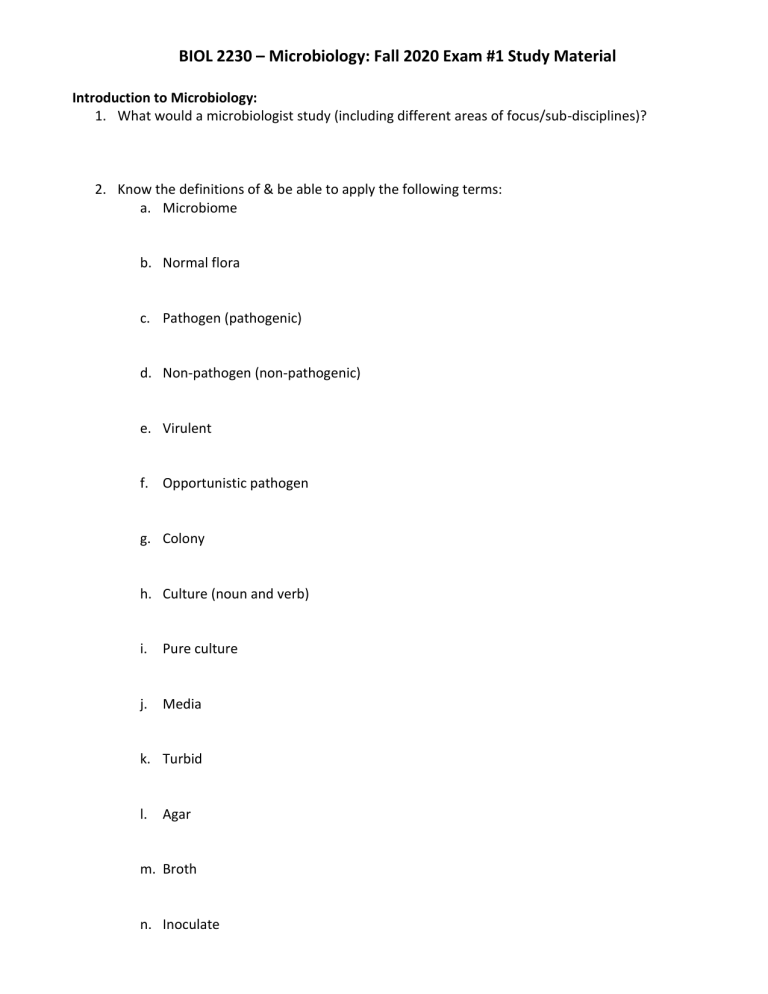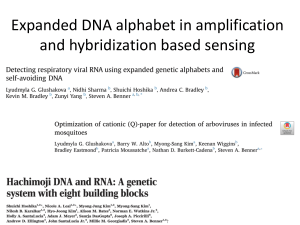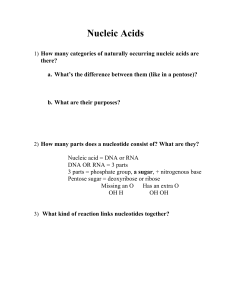
BIOL 2230 – Microbiology: Fall 2020 Exam #1 Study Material Introduction to Microbiology: 1. What would a microbiologist study (including different areas of focus/sub-disciplines)? 2. Know the definitions of & be able to apply the following terms: a. Microbiome b. Normal flora c. Pathogen (pathogenic) d. Non-pathogen (non-pathogenic) e. Virulent f. Opportunistic pathogen g. Colony h. Culture (noun and verb) i. Pure culture j. Media k. Turbid l. Agar m. Broth n. Inoculate o. Aseptic technique p. Magnification q. Resolution r. Contrast 3. Be able to recognize a description of each type of microorganism (bacteria, viruses, fungi, parasites, protozoa, algae, and archaea) 4. Know which types of microorganisms are prokaryotic and eukaryotic. 5. Be familiar with some examples of how microorganisms are beneficial. a. Aid in digestion in humans and animals b. Bioremediation c. Production of biofuels d. Food: fermentation (know what fermentation is & the different products it can make) 6. Know what eukaryotic and prokaryotic cells have in common and what is different between them. 7. Know the function of all the parts of a bright-field microscope 8. Know how to calculate the total magnification of a light microscope. 9. What is the purpose of staining a specimen or culture? 10. Who was the first person to describe bacteria viewed under a microscope? What did he call them? 11. Be able to recognize other contributions made by Pasteur. 12. What do Koch’s postulates prove? 13. Be able to list Koch’s postulates (in order) Bacterial Cell Structure 14. Know the three major morphologies (shapes) of bacterial cells 15. What is the bacterial cytoplasmic membrane made of? How is it arranged? 16. What are the functions of the bacterial cytoplasmic membrane? 17. Where is the bacterial cell wall located? 18. What is the main function of the bacterial cell wall? 19. Things to know about peptidoglycan: a. What is peptidoglycan and what is it made of? b. Why is peptidoglycan a good antibiotic target (2 reasons) 20. Know ALL the differences between Gram-positive and Gram-negative cells. a. What structural features are unique to each type (what does one have that the other doesn’t?) b. What color are Gram-positive and Gram-negative cells after a gram stain? c. How/why does the gram-stain work? 21. What is lysozyme? a. Where is it found? b. What does it do? 22. What is the function and location of the following: a. Outer membrane b. Lipopolysaccharide (know the three sections) i. How are lipid A and O-side chain virulence factors? c. Periplasm 23. Know the function & location of capsules 24. Know the function and location of fimbriae 25. Know the function and location of pili 26. Know the function and location(s) of flagella 27. What is the purpose of motility in bacteria? 28. Know the following about endospores: a. What they are b. When they form c. Why they form d. What the provide protection against e. Their potential lifespan 29. Know the definition of virulence factor and be able to recognize examples a. Know which bacterial structures have the ability to act as a virulence factor (for example: lipid A of LPS is a toxin) i. Are these structures virulence factors 100% of the time? Molecular Biology 1. What are the building blocks of proteins? 2. What are the building blocks of DNA and RNA? 3. What are the four bases found in DNA and RNA? 4. Know the complementary base pairs 5. What is the function of DNA? 6. What is the function of mRNA? 7. What is the purpose of supercoiling? What enzyme is responsible for supercoiling? 8. What is a plasmid? How do they function? 9. What is DNA replication? When does it take place in a bacterial cell? 10. What does DNA polymerase do? 11. What is transcription and its purpose? 12. What is a gene? 13. What does RNA polymerase do? 14. Why is RNA polymerase a good antibiotic target? (Hint: 2 reasons; same as cell wall) 15. What is translation and its purpose? 16. What is a codon? 17. What is the role of the ribosome in translation? 18. Why is the ribosome a good antibiotic target (Hint: 2 reasons; same as cell wall & RNA polymerase) 19. What is a mutation? 20. What is the difference between a mutant and wild type? 21. What are the three possible outcomes of a mutation? 22. What is horizontal gene transfer? Why is it beneficial for bacteria? 23. What is genomics? 24. What are examples of things we can learn from genomics? 25. How are PCR and Nucleic Acid Hybridization used in diagnostics? a. What type of infections can be diagnosed with PCR and Nucleic Acid Hybridization? b. What are advantages of PCR and Nucleic Acid Hybridization? c. What are PCR and Nucleic Acid Hybridization detecting? d. How are PCR and Nucleic Acid Hybridization able to amplify and/or detect pathogen specific nucleic acids?




